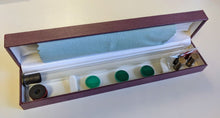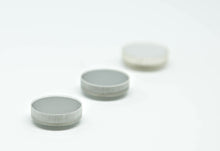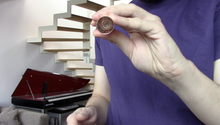Swap-Stopper Kit
flutealot
Regular price
£145.00
Sale
*** Currently sold out! Please contact me if interested in a backorder and I'll try and make one for you asap ***
Replace the cork in your concert flute with a customisable stopper. Experiment and get the sound and feel you want. Swap stopper faces in seconds. Introductory pricing.
The starter-kit comprising:
- 3 x swappable faces in sterling silver, titanium & zirconium
- 1 x Swap-stopper face removal & insert tool
- 1 x Swap-stopper back
- 1 x microfibre cleaning cloth
- 1 x carry case
- (1 x crown depending on the option chosen)
What is the swap-stopper?
There are two parts to the swap-stopper: The stopper face; and back.
Swap-Stopper Face
The face allows you to swap the material the end of the air column inside your headjoint interacts with. You can swap them in seconds easily using the tool included, while you leave the stopper back in the flute. You insert one end of the removal tool and it pulls the current face out. You then place the new face on the other end of the tool and insert into the headjoint - and as you get close to touching the base the face automatically attaches and centres itself.
I've tested many different materials, weights, shapes and finishes, from polished platinum to haphazardly-shaped rubbery plastics. This kit includes three materials: sterling silver, highly polished titanium, and highly polished zirconium. These are materials that, in my opinion, provide an attractive range of resistance, colour, and feel, at a cost-effective price. They are also hard-wearing.
I'm now offering an add-on 18k rose gold face too, due to demand for it, which you can find on this site.
Swap-Stopper Back
The back replaces cork assembly, with the following immediate benefits:
- No need to change the cork as it decays, resulting in a better long-term seal.
- Adjustable weight. Comes with 2 weights to add/remove. Some people find a heavier stopper focuses the sound (especially in the low register). Others may prefer lighter stoppers, to help flute balance or wrist issues.
- It opens up the chamber in the end of the headjoint, which some people find adds resonance.
- It is easy to remove to clean.
- Supports a range of faces available now, and ones that will be developed in the future.
Why change the face material?
Changing the face is similar to changing the riser material on the embouchure: it affects resistance, response, timbre, and projection. Each material and finish can feel quite distinct when played. It's a wonderful way to improve or customise the sound and feel of your headjoint without the expense of buying a new one. As precious metal prices continue to rise, it is fantastic to have a cost-effective alternative to a new headjoint, with the added benefit of allowing you to tweak your setup to suit today's venue/music/circumstances.
The faces I've developed are designed to offer a pleasant contrast, but each with plenty of "zing", volume, evenness and smoothness across the registers, ease of articulation and good projection. Over and above all, they are designed to "feel" good when playing and allow you to colour the sound. They do not go all out for one facet of playing e.g. pure volume, at the cost of flexibility and colour.
What about other materials?
I've experimented 50+ materials, shapes, sizes, weights, finishes, and manufacturing techniques. 18k Golds & Platinum are rewarding to play, but these precious metals come at a very high cost. I have worked hard and to high tolerances to achieve similarly attractive results (if not better!) with the zirconium, titanium and silver.
I've written a short blog entry about my thoughts on materials and the feel of the instrument. Please contact me for bespoke requirements.
The system
The swap-stopper allows you to buy one system and adjust it to find a setup you like. You can change swappers to suit the music, ensemble size, acoustic, or your mood. You can share them between multiple instruments and can change the weight of the stopper back by adding and removing weights.
I will continue to develop more faces in a variety of materials and shapes.
To read a bit more about how/why I created the swap-stopper, please see the little blog entry.
Who should buy this?
The swap-stopper is aimed at advanced amateurs and professionals. You should really have a well-setup instrument, with well-fitting headjoint, free of leaks before experimenting with any kind of flute gadget.
Customising is best done when you are comfortable with your own technique, and able to critically judge the effects of changes. Assessing any flute gadget should be done across a number of days, in varying circumstances in a range of acoustics, and by getting feedback from colleagues. What sounds powerful in your living room, may not carry for you across a symphony orchestra. For someone else, it might.
Practically speaking, you have to be comfortable removing your existing cork, or able to take your headjoint to a flute shop to have them remove it. Installing the swap-stopper is far easier than removing the original cork.
Do I need a new crown too?
You will not be able to use your existing crown if it requires a screw thread to attach. If you have an existing new-style crown, which usually has o-rings, then you will be able to use that with the swap stopper. Otherwise, you might like to purchase one of Robert Bigio's fantastic zirconium crowns or purchase a one from this site (they are designed to work well with the swap stopper).
Select a Crown option before adding to basket.
Why did you develop this?
I've written a short blog entry where can read a little more background about how the swap-stopper came to be made.
Installation
The initial installation involves inserting the stopper back into the correct position. You might find you never move/remove it again. Once that is done, you can swap faces in seconds.
Full installation video on Youtube.
Full installation instructions.
Will it fit my flute?
The swap-stopper is designed to fit almost all concert flutes and has been tested on a large number of metal and wood headjoints made from 1896 to the present day. For example, I use them in my regular modern gold Haynes, a student Yamaha, an old Louis Lot, a silver Nagahara, and my Bigio mopane headjoint.
Flute headjoints do come in a variety of designs. It is possible that your flute is unique/bespoke, or that has some damage such as a dent or bend that might hinder installation. The stopper-back should push relatively easily past the embouchure hole, given a firm-but-gentle push - especially if you first wet the o-rings or put a little vegetable/olive oil on them.
If you think your flute has an unusually wide or narrow bore, then please feel free to check with your preferred repair person or manufacturer first, and provide me with a measurement of the bore size at or after the embouchure hole. Another good check would be to measure the widest diameter of your existing cork using a vernier caliper.
Safety
Please read and understand the safety information about magnets before purchasing and using this product.






